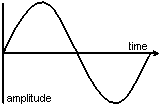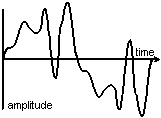The long-awaited HUMAN 81 DK is now available.
Best viewed in "landscape" mode.
| Sound & Hearing Recordings |
Woofers, Tweeters Passive Radiators |
Acoustic Suspension Crossover Networks |
Loudspeakers Subwoofers |
What we refer to as sound, and experience as noise, music and speech, among other things, is a series of changing compressions and rarefactions of the atmospheric gases around us. Compression is a slightly higher pressure than the surrounding air, rarefaction is slightly lower. The simplest sound would consist of what we would hear as a "pure tone," and would consist of a gentle smooth curve, if it was graphed. The pressure would increase to a maximum level and then decrease to a minimum level and back again. This is the sort of sound produced by an electronic oscillator when hooked up to amplification equipment and a loudspeaker, or a very simple physical resonating device, like a tuning fork.
| Here is a single "cycle" of a pure sine wave. For this to be heard as a continuous tone it would keep repeating along the "time" axis. Also its amplitude would need to be strong enough to be heard and its frequency (how often it completes the curve as shown) would need to be in the range of human hearing. |  |
The "wavelength" is the distance between two similar points on this curve - for instance two points of maximum compression. One entire wavelength is shown in the picture above. The frequency is how many of these wavelengths happen in one second. These two are a function of each other and the speed of the wave in the medium concerned - in our case, the speed of sound (or pressure waves) in air, at sea level, is about 1100 feet (340 meters) per second. (The air itself does not move from place to place at this speed - the energy of the wave itself is what moves along, the air molecules themselves slightly altering position to achieve the pressure changes - this is easiest to imagine by watching a floating object bobbing in water while waves from a splash pass by it.)
In the real world, sound waves of this sort rarely occur. Almost all objects that vibrate will tend to do two things that alter this "waveform." One is that will also vibrate to varying extents at frequencies that are multiples of the lowest one, or "fundamental." These are called "harmonics" of the fundamental frequency. Also, they will usually resonate in a more complex fashion than the nice clean sine wave - some more than others, of course. A column of air excited by a breeze over it (try to think of a natural example...) will behave pretty nicely, as will most mechanical systems subjected to a linear restoring force, functionally similar to a weight on a spring (a spring exerts a linear restoring force when it is compressed or stretched). If a system is more complex, and most real ones are, there will accordingly be changes in the waveform, which are not harmonic in nature. These two effects, the "harmonic envelope," and the non linearity of the object, combine to create the characteristic sound of the things we hear. (in sound reproduction, if these effects are added to the signal by the equipment they are known as "distortion," usually harmonic, non-linear, or noise)
| This illustration shows a single cycle of a slightly complex, but still symmetrical, waveform. If we were to analyse it, it could be shown to be the sum, or superimposition, of several, perhaps dozens, of different sine waves taken together. Its sound would be equally complex, though the symmetry indicates that all the waves that compose it are harmonic multiples. |  |
Of course, vibrations in the air are not all it takes to make "sound." On their own they are just energy dissipating from a source. Without a Buddhist monk somewhere nearby to hear them, they might as well not even exist...
When these waves of acoustic energy reach a listener, they might be heard. Some will be outside the range of hearing - the sense of hearing has evolved (due to physical limitations and practicality both) to be limited roughly to frequencies from about 20 cycles per second (or Hertz, abbreviated Hz) to about 15 to 22 thousand Hz. This range represents about ten octaves, or doublings of frequency depending on the individual. Which is amazing, when you remember (I hope you remember) that the visible light spectrum does not even encompass one doubling of frequency!
The lowest of the frequencies might be experienced more viscerally, or felt, as rumblings or even actual motion. The highest will probably only be perceptible as an increased irritation from your dog, or perhaps bats getting confused.
Without going into too much depth concerning the biology of the structure of the ear, what happens next is that the rapidly changing pressure waves in the air are transferred, via the external ear and ear canal, to the eardrum, which in turn passes them along via the ear bones (you know, the hammer, stirrup and anvil) to the cochlea in the inner ear. Interestingly enough, the cochlea does two seemingly unrelated things - it processes these vibrations and gets them to the brain, and it also serves our system of balance - or perception of physical motion. The cochlea is lined with eleventeen zillion tiny hairs, which stimulate nerve endings and as a result feed electrochemical signals into the brain that are representational of the original air compressions that caused them, and also, as a consequence, of the object that caused the air to move.
At this point the incredible processing system comprised of various parts of the human brain takes over. At first, the sound, any sound, is just noise. Noise is disorganised information - or a lack of information. It can be random, and either cannot be understood or has no useful meaning - like the chatter of teenagers. Our brains not only learn to recognise certain patterns (a huge number of patterns, actually!), but can decipher them when they are mixed in with many others, meaningful or not.
Imagine a parent at the seashore, engaged in conversation with a friend. The sound of the splashing water is present, and perhaps the wind in the trees adds another meaningful but unimportant component to the waves reaching the eardrum. There is laughter and shouting, near and distant. Perhaps sounds of boaters are there as well, and waves may be rhythmically crashing, too. This person is able to make sense of the language and words of their companion in spite of all this clutter, all the while keeping a small part of their attention reserved for the possibility of the sound of their child's voice, among all other voices, calling to them.
Music is an amazing thing. At a very basic level, its rhythms coax us to move in time to them, to tap our feet or dance. These rhythms also create a structure within which the melodic elements operate - varying sequences of tones which in their order and interrelationships can take on powerful meanings. In addition to the simple course of a series of notes there is usually a harmonic structure, consisting not only of the sound of the instruments or voices, but the sounds of other voices which may be adding other related or unrelated tones at any given moment in their own separate part. Thousands, even millions, of pieces of information are contained in even a moment of music, and we can learn to sift through them and follow any one or several of the possible aspects of its meaning, virtually at will. While we do it we might be moved to an emotional response, thoughtful about the technical aspects or harmonic structures of the piece, or imagining the story told by the lyric - or even the instruments.
No wonder it is so wonderful to be able to listen to our favorite recorded music on equipment that preserves these many complex sounds and delivers them accurately, unchanged in their inner relationships and harmonies, without undue added distortions or background noise, to our eager ears.
* * *
Top - Contact
New Speakers -
EPI and Epicure - Genesis Physics
© Copyright - All Rights Reserved
![]()
7 Kelsey Road, Lee, New Hampshire 03861
Prices can change and specifications will improve without notice
